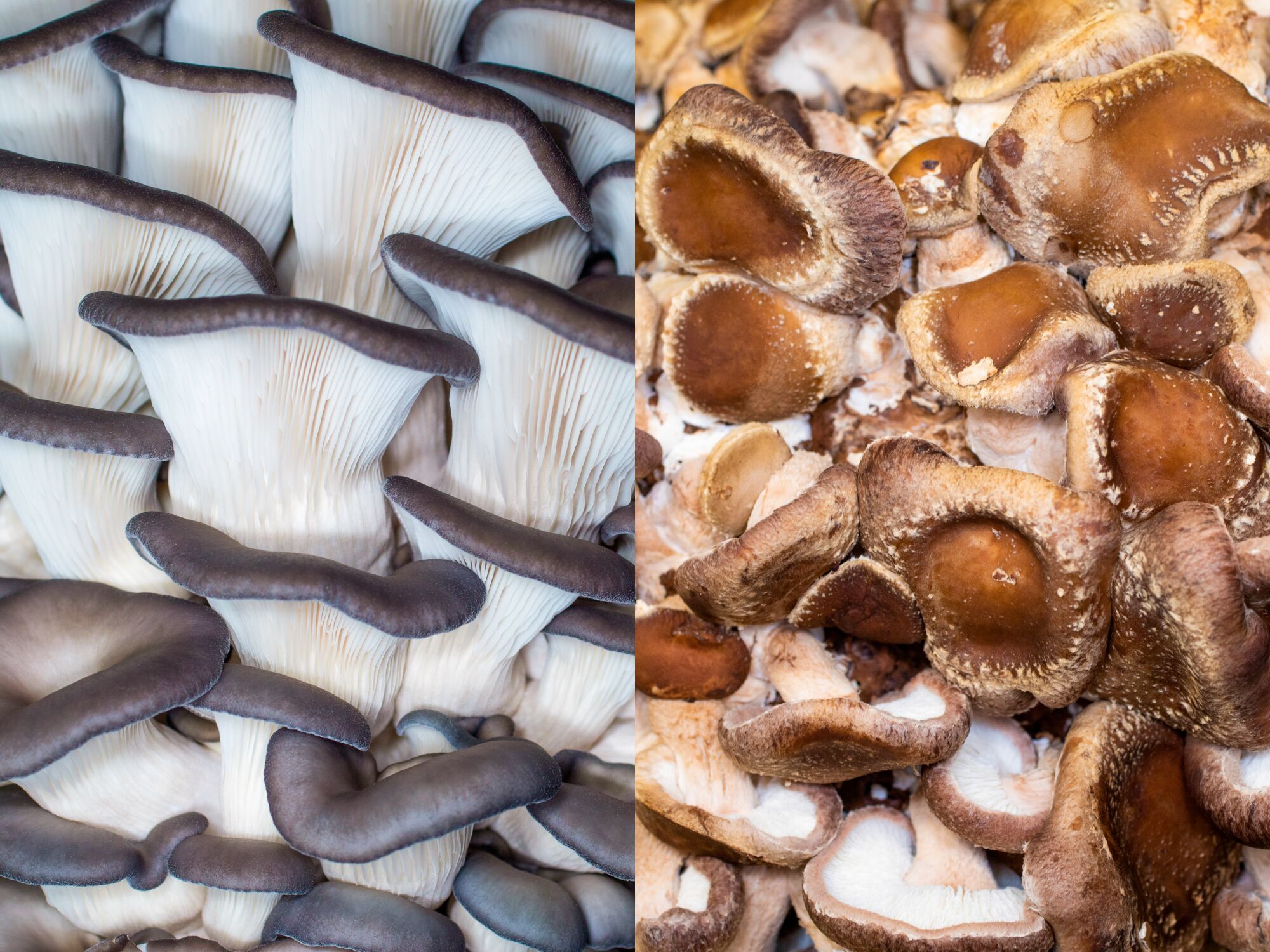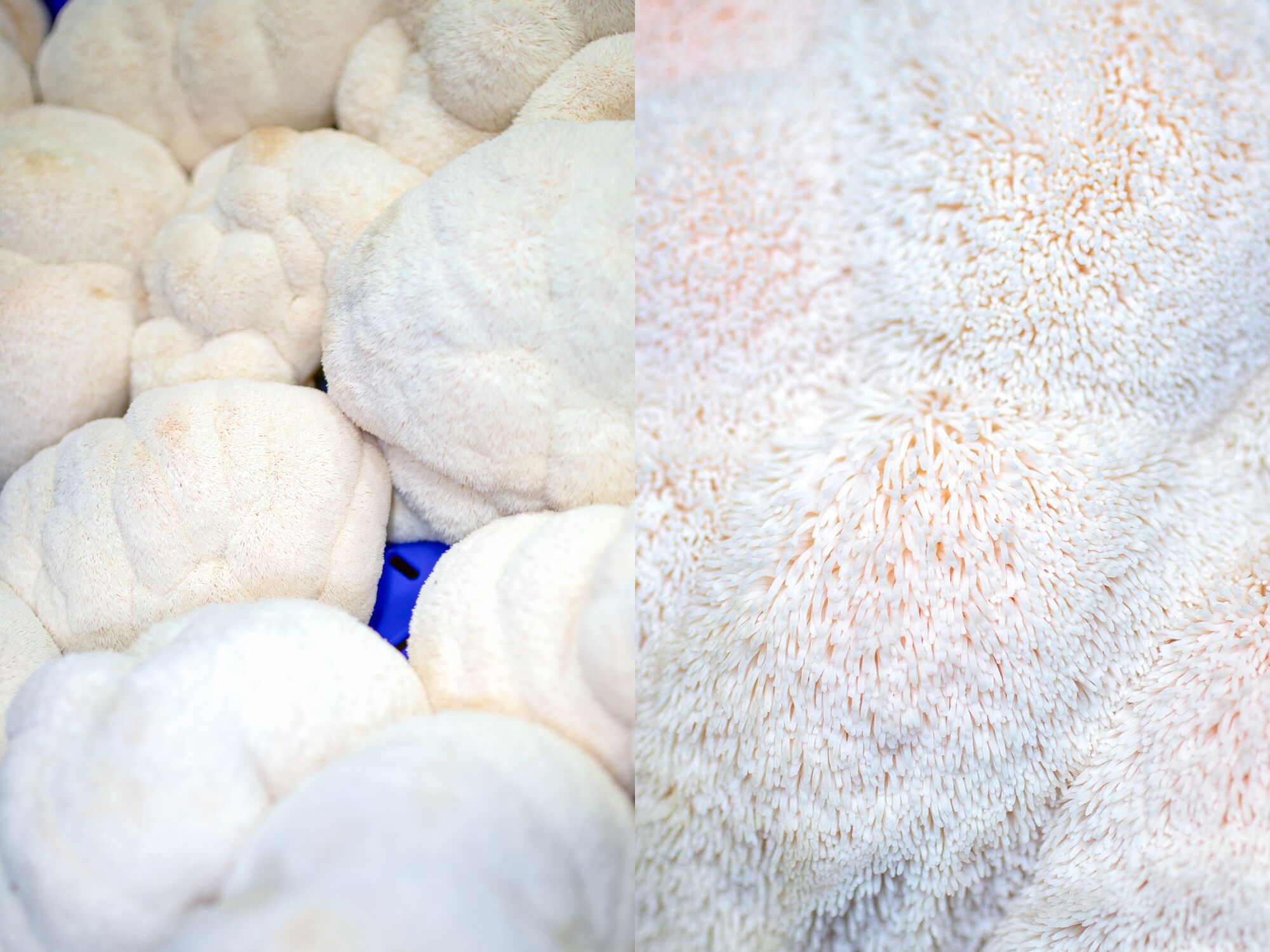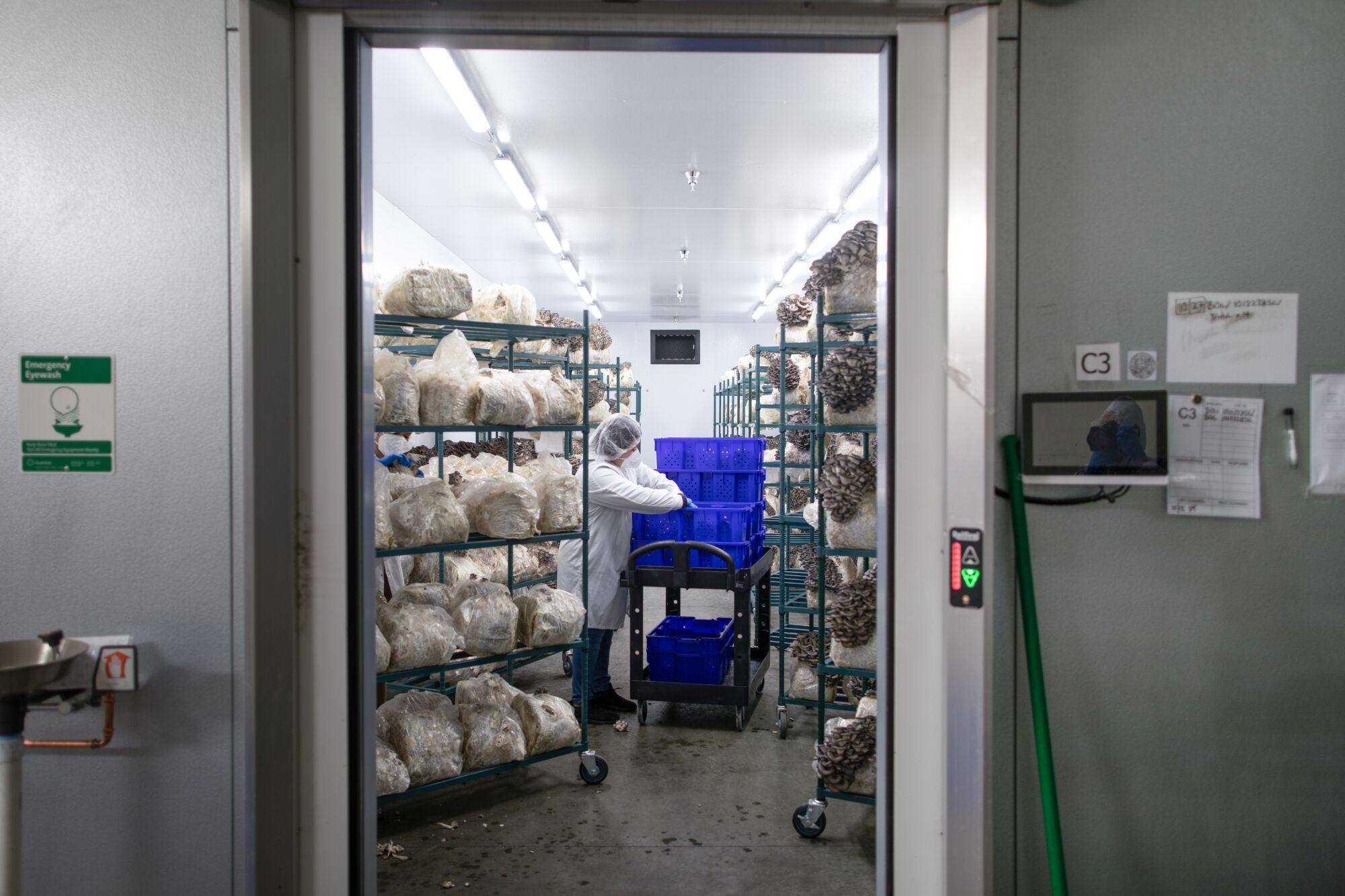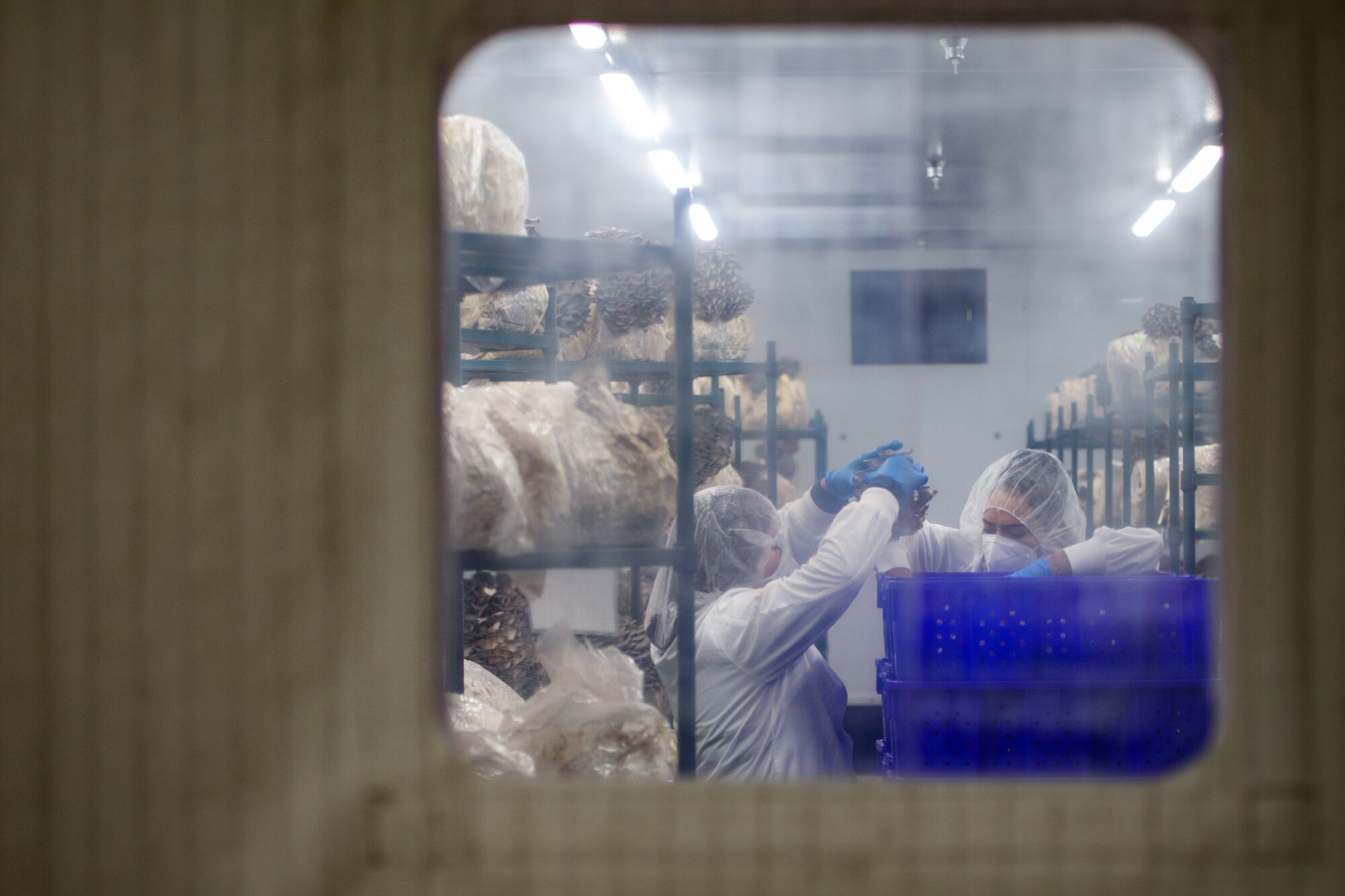The fungi future is here — at an urban mushroom farm just south of downtown L.A.

[ad_1]
A mushroom revolution is happening on the grocery retailer cabinets of Southern California: Within the produce sections of markets throughout Los Angeles, Agaricus bisporus, generally often called the white button mushroom, is giving strategy to different dazzling fungi species comparable to blue oyster, lion’s mane, maitake and royal trumpet.
Lots of them possible are cultivated in a sprawling warehouse in the course of Vernon — the commercial metropolis simply south of downtown L.A. — the situation of an city mushroom farm that New York-based firm Smallhold opened 5 months in the past.
In a 34,000-square-foot constructing, on the identical road as a producer of ready-mix concrete and a Dr Pepper distributor, Smallhold grows mushrooms of fantastical show and scale — a number of thousand kilos of mushrooms per week, or tens of 1000’s of kilos within the close to future, if all goes as deliberate.

Blue oyster mushrooms, left, and shiitake mushrooms, proper.
(Myung J. Chun / Los Angeles Instances)
“We have now the capability to reap greater than 20,000 kilos per week,” stated co-founder and Chief Govt Andrew Carter. “Our objective is to feed 2 million folks within the U.S. with mushrooms by the tip of 2022. We’re very a lot on monitor.”
Few different classes of produce have captured customers’ collective creativeness like mushrooms. Not a vegetable, mushrooms (like crops and animals) belong to their very own organic kingdom: fungus. In recent times, a fascination with all issues fungi has paralleled meals and well being tendencies: consuming much less meat, foraging and a rising curiosity in meals as drugs (together with the scientific use of psilocybin, which naturally happens in a special class of ’shrooms — the psychedelic ones).
Numerous podcasts, books, social media accounts, music, motion pictures and on-line quizzes (“Which mushroom are you?”) are dedicated to fungi. Louie Schwartzberg’s 2019 hit documentary “Implausible Fungi” featured legendary mycologist Paul Stamets, who famous that analysis exhibits compounds in lion’s mane mushrooms will help battle dementia-related cognitive dysfunction. Fungi, apparently, can also talk with timber, enhance our immune methods and assist clear the atmosphere.

The phases of lion’s mane mushrooms, too delicate to ship lengthy distances. Smallhold grows native mushrooms for an space inside 500 miles of its city farm in Vernon.
(Myung J. Chun / Los Angeles Instances)
So it isn’t shocking that mushroom gross sales on the whole have boomed. After the preliminary shock of the pandemic in early 2020, weekly U.S. mushroom gross sales constantly rose greater than 20% year-over-year between April and July (matched solely by oranges and limes within the produce part), in accordance with analysis agency IRI. That very same 12 months the worldwide market hit $54 billion, and it’s anticipated to achieve $86 billion by 2026.
“There’s much more room for folks to include mushrooms into their lives,” Carter stated. “We simply maintain going for it.”
What began as Carter’s experiment rising trumpet mushrooms in a basement in 2015 has grow to be an organization of 115 workers in three states, promoting mushrooms to greater than 500 shops throughout the nation and an increasing roster of cooks and eating places.
Carter, beforehand a grower and guide for greenhouse operations, launched Smallhold with co-founder Adam DeMartino in 2017 in Brooklyn, finally shifting right into a facility close to the Navy Yard, which is a tenth the scale of the Los Angeles farm. Towards the tip of 2020 the corporate opened one other facility in Buda, Texas, exterior of Austin. The L.A. mushroom farm is its greatest and most superior but, Carter stated.
“We’re attempting to carry contemporary, native, licensed natural mushrooms all through the nation, which looks as if a easy activity, however it means it’s important to develop in these areas,” he stated. “That turns into very sophisticated.
“Oyster mushrooms, lion’s mane, maitake, shiitake — all of those don’t ship that nicely. So rising them nearer to the patron, it’s higher for the patron,” Carter stated. “The know-how we use and strategies we use are considerably decrease in carbon footprint than every other mushroom farm, and our water print is negligible. You couldn’t actually discover a lot meals that makes use of much less water than Smallhold.”

Farm affiliate Kelly Garcia harvests blue oyster mushrooms in one of many rising chambers at Smallhold.
(Myung J. Chun / Los Angeles Instances)

Royal trumpet mushrooms develop in substrate of compressed, sanitized byproduct from the timber business blended with grains or different vitamins. As soon as the mushrooms are harvested, the substrate is composted.
(Myung J. Chun / Los Angeles Instances)
“Beep, beep, beep, beep.” It’s the sound of a near-perfect atmosphere for a mushroom. Extra exactly, it’s the noise that the automated, motion-sensing roll-up doorways of insulated rising chambers make as they open and shut. Digital screens exterior of the 24 chambers — every chamber the scale of a small studio house — point out the inside temperature, carbon dioxide degree and humidity, what the workers at Smallhold name local weather recipes.
Inside one of many chambers, wall-to-wall shelving holds blue oyster mushrooms (Pleurotus ostreatus). Some are simply beginning to bear fruiting our bodies, or sporing our bodies. The fruiting physique is the mushroom, and it develops from mycelium — a fungus’ community of filaments — as a part of its reproductive course of.
Mycelium absorbs and breaks down surrounding natural matter; on this case, it’s blocks of substrate (quite than decaying logs on the forest ground). The substrate is made with byproduct from the timber business — blended with grain or different vitamins — and inoculated with the mycelium. (After the mushrooms are harvested, the substrate is given away to be reused by clients, who can develop their very own mushrooms with it; composted; or studied as a part of a mycoremediation venture to rehabilitate contaminated land.)
“The fruiting course of is absolutely depending on the atmosphere, and the atmosphere is kind of advanced,” Carter stated. To dial within the local weather recipe for every sort of mushroom, Smallhold developed a patented know-how for capturing lots of of 1000’s of information factors every day. “The climates are primarily based on the completely different areas that they’re from. You may think about a misty forest ground in spring to develop an oyster mushroom.
“However these evolve fairly a bit over time as a result of we’re accumulating a lot information and we all know easy methods to develop these in a extra optimum approach.”
The info is carefully monitored by a workforce of engineers at Smallhold’s New York headquarters. As quickly because the Los Angeles workforce arrives every morning on the Vernon location, engineers are able to make any changes. “It additionally takes palms, eyes — we have now lots of people,” stated Jesse Goldman, normal supervisor of Smallhold in Southern California. “We’re in fixed contact with them to point out them what’s taking place in right here and to ensure we’re rising every part we have to.
“There aren’t any days off on the farm. There’s at all times somebody right here working, at all times extra work to be accomplished. Mushrooms don’t cease for us.”

Blue oyster mushrooms are packaged in paper (quite than plastic) cartons at Smallhold.
(Myung J. Chun / Los Angeles Instances)
He pointed to a cluster of dozens of blue oysters, a tower of overlapping mushrooms stretching upward from their substrate. “Right here’s some lovely coloration right here. These are actually blue, actually blue,” Goldman stated. “That’s all mild impact. That is the early fruiting physique coloration, and as they mature they get a bit extra grey.
“It’s all in regards to the cap and gills on the facet. The caps begin to fold up and gills begin to present themselves. We search for a extra even cap, barely turned, with gills staying good and lined up and straight. This one is prime.”
A couple of chambers over, younger lion’s mane (Hericium erinaceus) — pink and brainlike in its early sporing stage — crammed the room. Inside per week they may grow to be fluffy white, with an inside construction like cauliflower and creamy white gills, referred to as enamel, that cascade down in a shaggy pompom. “It’s my favourite mushroom,” Goldman stated. “I prefer to make lion’s mane steaks and a pulled-pork variation.”
Till not too long ago, the button mushroom was virtually synonymous with “mushrooms” in grocery shops. With its completely domed cap and brief, sturdy stem, it was first cultivated on a heap of horse manure in France within the 1700s. In Nineteen Twenties Pennsylvania, a farmer (who additionally was a mycologist) seen white mushrooms among the many sometimes brown ones of mature A. bisporus and commenced harvesting the creamy-colored model, which took off in reputation. However white button, brown cremini and large portobellos are all the identical selection. And traditionally, they’ve represented 90% of the mushroom market, a lot of which remains to be grown in Pennsylvania.
However the cultivation of specialty mushrooms — any not belonging to the genus Agaricus — has boomed since shiitakes first hit U.S. supermarkets within the Nineteen Eighties. By 2019, greater than 300 small-scale mushroom farms throughout the nation have been rising and harvesting at the least 20 kilos of mushrooms per week, in accordance with the Cornell School of Agriculture and Life Sciences. Shiitake (Lentinula edodes) and oyster (Pleurotus ostreatus) are the most typical specialty mushrooms; they’re the second- and third-most produced mushrooms within the U.S.
“Now you can discover such nice mushrooms at your market,” stated creator and photographer Andrea Gentl at a current dialogue for her new cookbook, “Cooking With Mushrooms: A Fungi Lover’s Information to the World’s Most Versatile, Flavorful, Well being-Boosting Elements,” a sold-out occasion organized by e book retailer Now Serving at Botanica Restaurant. “The purpose of this e book was actually in regards to the cultivated mushroom growth and the way now they’re extra accessible to everybody.”
“I used to consider mushrooms as one thing on pizza,” stated April Valencia of Masa Reminiscence, one of many moderators for the dialogue. Gentl’s e book consists of recipes for king trumpet schnitzel, shiitake kofta, pots de crème with porcini and chocolate, and mushroom-rose-rye granola with powdered maitake, cordyceps and reishi.
“We actually wish to carry attention-grabbing varieties to the grocery retailer,” Carter stated. Smallhold grows about 14 varieties, specializing in six “hero mushrooms” — blue and yellow oyster, lion’s mane, maitake, shiitake and royal trumpet. Goldman stated there are plans to develop turkey tail, named for its fanlike form and variegated brown coloration, in addition to reishi and seasonal varieties comparable to black pearl.
“We’re an enormous group of individuals right here obsessive about mushrooms,” Carter stated. “The extra mushroom folks you speak to, you notice when you get into it, it takes over your mind.”

Smallhold developed know-how to watch the local weather for every rising chamber. “Each resolution we make is in service of the mushrooms,” stated Jesse Goldman, supervisor for Southern California.
(Myung J. Chun / Los Angeles Instances)




